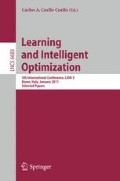Abstract
Genetic programming is a good technique for finding near-global optimal solutions for complex problems, by finding the program used to solve the problems. One of these complex problems is designing stream cipher systems automatically. Steam cipher is an important encryption technique used to protect private information from an unauthorized access, and it plays an important role in the communication and storage systems. In this work, we propose a new approach for designing stream cipher systems of good properties, such as high degree of security and efficiency. The proposed approach is based on the genetic programming. Three algorithms are presented here, which are simple genetic programming, simulated annealing programming, and adaptive genetic programming. Experiments were performed to study the effectiveness of these algorithms in solving the underlying problem.
Access this chapter
Tax calculation will be finalised at checkout
Purchases are for personal use only
Preview
Unable to display preview. Download preview PDF.
References
Szaban, M., Seredynski, F., Bouvry, P.: Collective Behavior of Rules for Cellular Automata-Based Stream Ciphers. In: IEEE Congress on Evolutionary Computation, pp. 179–183 (2006)
Clark, A., Jacob, L.J.: Almost Boolean functions: the design of Boolean functions by spectral inversion. Computational Intelligence 20(3), 450–462 (2004)
Millan, W., Clark, A., Dawson, E.: An effective genetic algorithm for finding highly nonlinear Boolean functions. In: Proc. 1st Int. Conf. on Information and Communications Security, China, Beijing, pp. 149–158 (1997)
Awad, W.S.: The applications of GA in cryptology. Far East Journal of Experimental and Theoretical Artificial Intelligence 2(1), 59–76 (2008)
Eiben, A.E., Hinterding, R., Michalewic, Z.: Parameters control in evolutionary algorithms. IEEE Trans. Syst. Man Cybern. 16(1), 122–128 (1999)
Van Laarhoven, P.J.M., et al.: Simulated Annealing: Theory and applications. Reidel, Holland (1987)
Sadegheih: Sequence optimization and design of allocation using GA and SA. Applied Mathematics and Computation 186(2), 1723–1730 (2007)
Yuichiro, U., Mitsunori, M., Tomoyuki, H.: Simulated Annealing Programming Using Effective Subtrees. Doshisha Daigaku Rikogaku Kenkyu Hokoku 49(4), 205–209 (2009)
Miki, M., Hashimoto, M., Fujita, Y.: Program Search with Simulated Annealing. In: Proc. of the 9th Annual Conference on Genetic and Evolutionary Computation, London, England, pp. 1754–1754 (2007)
Sivanandam, S.N., Deepa, S.N.: Introduction to genetic algorithms. Springer, New York (2008)
Srinivas, M., Patnaik, L.M.: Adaptive Probabilities of Crossover and Mutation in Genetic Algorithms. IEEE Trans. Systems, Man and Cybernetics 24(4), 656–667 (1994)
Zhang, J., Hu, T.: Adaptive Genetic Algorithm Based on Population Diversity. Computer Engineering and Applications 9(1), 49–51 (2002)
Forouzan, B.A.: Cryptography and network security. McGraw-Hill, New York (2008)
Rueppel, R.A.: Analysis and Design of Stream Cipher. Springer, New York (1986)
Schneier, B.: Applied cryptography. John Wiley and Sons, New York (1996)
Golomb, S.W.: Shift Register Sequence. Holden-Day, San Francisco (1967)
Beker, P.F.: Cipher Systems. John Wiley, New York (1982)
Klapper, G.M.: Feedback shift registers, 2-adic span and combiners with memory. Journal of Cryptology 10(1), 111–147 (1997)
Dubrova, E., Teslenko, M., Tenhunen, H.: Analysis and Synthesis of (n,k)-Non-Linear Feedback Shift Registers. In: Proc. of the Conf. on Design, Automation and Test, Munich, Germany, pp. 1286–1290 (2008)
Goresky, M., Klapper, A.: Pseudonoise Sequence Based on Algebraic Feedback Shift Registers. IEEE Trans. Inf. Theory 52(4), 1649–1662 (2006)
Gustafson, H., et al.: A computer package for measuring the strength of encryption algorithm. Comp. and Sec. 14(1), 687–697 (1994)
Zeng, K., Yang, C., Rao, T.R.N.: Pseudorandom Bit Generator in Stream Cipher Cryptography. Comp. 2(24), 8–17 (1991)
L’ecuyer, P., Simard, R.: TestU01: A C library for empirical testing of random number generators. ACM Trans. Math. Softw. 33(4), 22–40 (2007)
Massey, J.L.: Shift register sequences and BCH decoding. IEEE Trans. on Inf. Theory IT 15(1), 122–127 (1976)
Eberhart, R., Shi, Y.: Computational Intelligence: concepts to implementation. Morgan Kaufmann, San Francisco (2008)
Koza, J.R.: Genetic programming. MIT Press, Cambridge (1992)
Goldberg, D.E.: Genetic algorithms in search, optimization, and machine learning. Addison-Wesley, New York (1989)
Mitchell, M.: An Introduction to Genetic Algorithm. MIT Press, Cambridge (1996)
Holland, J.H.: Adaptive in natural and artificial systems. University of Michigan, Ann Arbor (1975)
Hirsh, H., Banzhaf, W., Koza, J.R., Ryan, C., Spector, L., Jacob, C.: Genetic programming. IEEE Intelligent Systems 15(3), 74–84 (2000)
Koza, J.R., Keane, M.A., Streeter, M.: What’s AI done for me lately? - genetic programming’s human competitive results. IEEE Intelligent Systems 18(3), 25–31 (2003)
Koza, J.R.: Genetic Programming II: Automatic Discovery of Reusable Programs. MIT Press, Cambridge (1994)
Kirkpatrik, S., et al.: Optimization by simulated annealing. Science 220(4598), 671–680 (1983)
Yong, L., Lishan, K., Evans, D.J.: The annealing evolution algorithm as function optimizer. Parallel Computing 21(3), 389–400 (1995)
Cordon, O., et al.: An Inductive Query by Example Technique for Extended Boolean Queries Based on Simulated-Annealing Programming. In: The Proc. of 7th International ISKO Conference on Challenges in Knowledge Representation and Organization for the 21st Century, pp. 429–436. Integration of Knowledge Across Boundaries, Granada (2002)
Haynes, T., et al.: Strongly typed GP in evolving cooperation strategies. In: Proc. of the sixth Int. Conf. on GA, pp. 271–278. Morgan Kaufmann, San Francisco (1995)
Author information
Authors and Affiliations
Editor information
Editors and Affiliations
Rights and permissions
Copyright information
© 2011 Springer-Verlag Berlin Heidelberg
About this paper
Cite this paper
Awad, W.S. (2011). Designing Stream Cipher Systems Using Genetic Programming. In: Coello, C.A.C. (eds) Learning and Intelligent Optimization. LION 2011. Lecture Notes in Computer Science, vol 6683. Springer, Berlin, Heidelberg. https://doi.org/10.1007/978-3-642-25566-3_23
Download citation
DOI: https://doi.org/10.1007/978-3-642-25566-3_23
Publisher Name: Springer, Berlin, Heidelberg
Print ISBN: 978-3-642-25565-6
Online ISBN: 978-3-642-25566-3
eBook Packages: Computer ScienceComputer Science (R0)

